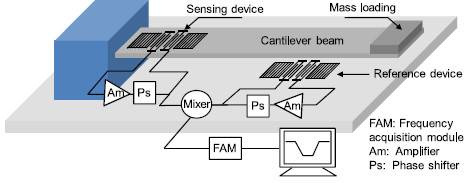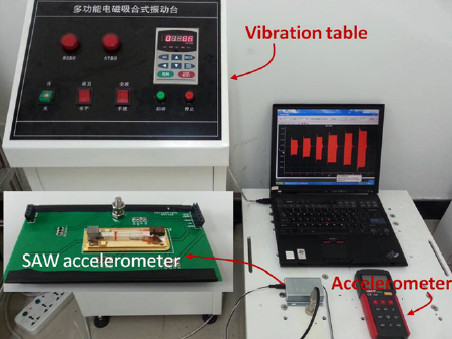As the core component in the inertial measurement system, the acceleration sensor is used to measure the motion status of the object utilizing its inertial properties. The acceleration sensor has seen diverse applications ranging from aviation, aerospace and astronomy to petrochemical and transportation.
Among a wide variety of acceleration sensors, the surface acoustic wave (SAW)-based acceleration sensor has gained increasing attraction for its inertial application. It exhibits some unique properties as a simple structure that is convenient to manufacturer with no auxiliary equipment. Besides, it also costs low, has good impact resistance, offers a stable and reliable performance and has high sensitivity.
Researchers from the Institute of Acoustics (IOA), Chinese Academy of Sciences have successfully demonstrated the implementation and performance of a SAW-based acceleration sensor.
The sensor incorporates a ST-X quartz cantilever beam, utilizing a differential resonator-oscillator structure, as shown in Fig. 1.

Fig. 1. The schematic of the SAW acceleration sensor incorporating the cantilever beam (Image by IOA).
It is composed of a flexible ST-X quartz cantilever beam with a relatively substantial proof mass at the undamped end. A pattern of a two-port SAW resonator with an operating frequency of 300 MHz is deposited directly on the surface of the beam. It is adjacent to the clamped end for maximum strain sensitivity. And a SAW resonator is affixed on the metal package base for temperature compensation.
The acceleration is directed to the proof mass flex of the cantilever, inducing relative changes in the acoustic propagation characteristics of the SAW traveling along the beams.
The frequency signal from the differential oscillation structure utilizing the SAW resonators as the feedback element varies as a function of acceleration.
The sensor response mechanism is analyzed theoretically, with the aim of determining the optimized dimension of the cantilever beam. The coupling of modes model is used to simulate the synchronous SAW resonator prior to fabrication.
The oscillator frequency stability is improved using the phase modulation approach. And the obtained typical short-term frequency stability ranges up to 1Hz s-1.
The performance of the developed acceleration sensor is evaluated using the precise vibration table and is also evaluated in comparison to the theoretical calculation. A high frequency sensitivity of 29.7 kHz g-1, good linearity and a lower detection limit (<1×10-4 g) are achieved in the measured results.
The measurement set-up of the SAW acceleration sensor is shown in Fig. 2. The measured results indicate that the developed SAW accelerometer is very promising for inertial applications.

Fig. 2. The measurement set-up of the SAW acceleration sensor (Image by IOA).
Funding for the research came from the National Natural Science Foundation of China: no.11374254.
References:
WANG Wen, HUANG Yangqing, LIU Xinlu, LIANG Yong. Surface Acoustic Wave Acceleration Sensor with High Sensitivity Incorporating ST-X Quartz Cantilever Beam. Smart Materials and Structures (Vol. 24, No. 1, January 2015). DOI. 10.1088/0964-1726/24/1/015015
Contact:
WANG Wen
State key Laboratory of Acoustics, Institute of Acoustics, Chinese Academy of Sciences, 100190 Beijing, China
Email: wangwenwq@mail.ioa.ac.cn


